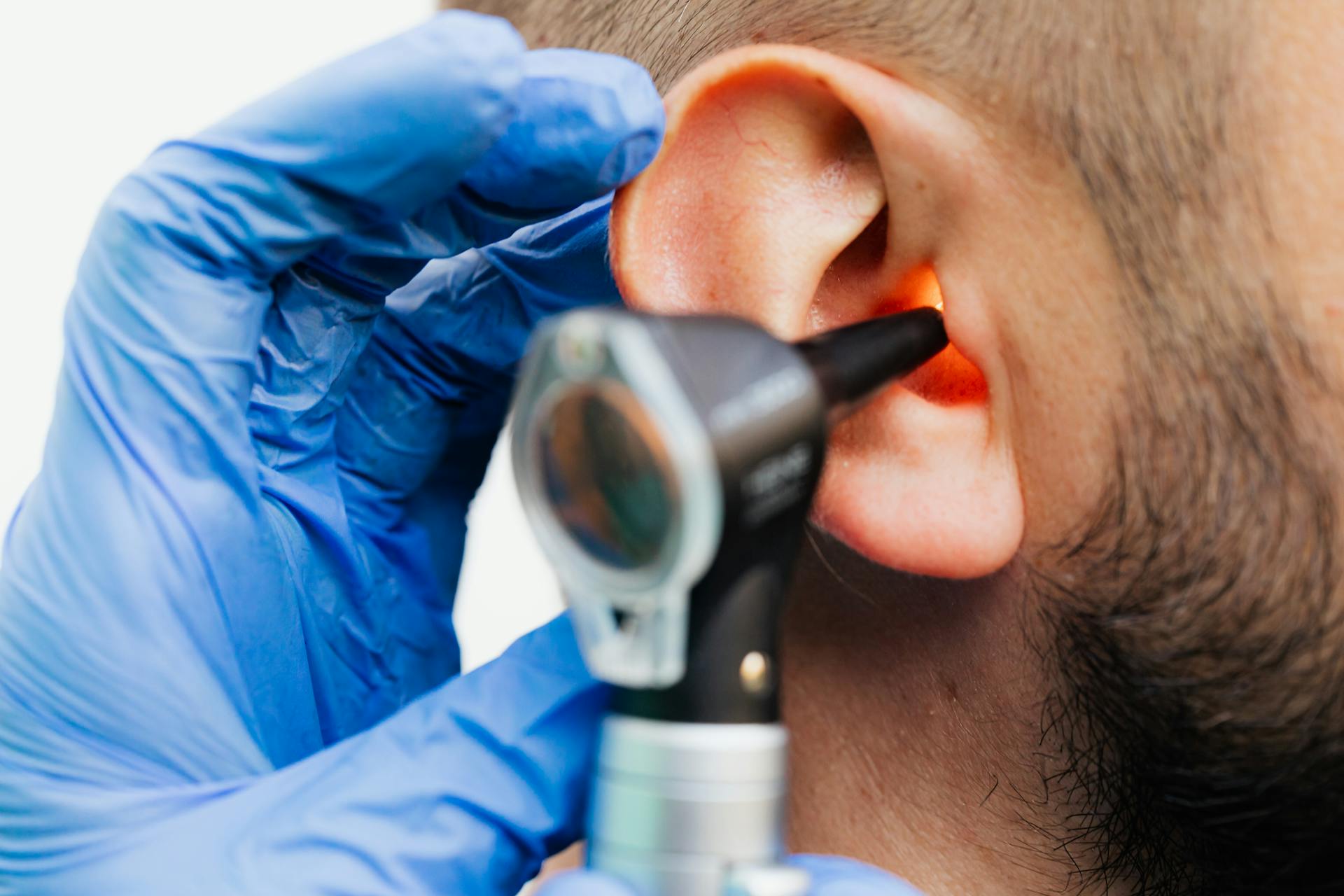
Sudden hearing loss in dogs can be a scary and confusing experience for pet owners. Sudden hearing loss can occur suddenly and without warning, often within a 24-hour period.
The exact cause of sudden hearing loss in dogs is still not fully understood, but it's thought to be related to a sudden blockage or damage to the ear's inner structures, such as the hair cells in the cochlea. Sudden hearing loss can be a sign of an underlying medical condition, such as a middle ear infection, a tumor, or a head injury.
Symptoms of sudden hearing loss in dogs can vary, but common signs include a sudden loss of hearing, whining or whimpering, and tilting the head to one side.
Broaden your view: Dog Sudden Aggression
Causes of Sudden Hearing Loss
Sudden hearing loss in dogs can be caused by head trauma, such as being hit by a car. This type of trauma can result in both temporary and permanent deafness.
Trauma to the head is a serious issue that requires immediate attention. If you suspect your dog has suffered head trauma, seek veterinary care right away.
Chronic ear infections of the ear canal or middle ear can also cause sudden hearing loss. These types of infections are often treated with antibiotics, but if the infection has caused extensive damage, hearing loss may be permanent.
In some cases, the hearing loss caused by ear infections is not reversible. This means that your dog will have to adapt to living with hearing loss, which can be challenging for both you and your pet.
Identifying and Diagnosing
Dogs that are bilaterally deaf from a young age are often easy to recognize, but identifying deafness in dogs that become deaf later in life can be more challenging.
Puppies with hereditary deafness don't react to noises like other dogs, which can be a clear indication of hearing loss.
Related reading: Are Dalmatian Dogs Deaf
If you suspect your dog might have hearing loss, a simple way to check is to shake your keys or make a beeping noise from behind them while they're not expecting it.
If they prick their ears or look towards the noise, it's likely they can hear. However, this test is not a definitive diagnosis and a veterinarian will need to examine your dog.
A veterinarian will conduct a complete exam, including examining the inner ear canal for any abnormalities, and may perform a simple hearing test by making loud noises and observing your dog's response.
Additional tests, such as brainstem auditory evoked response (BAER) testing, may be necessary to determine the best course of action.
BAER testing is the gold standard in deafness diagnosis and involves detecting electrical activity in the cochlea and auditory pathways in the brain.
Here are some signs to look out for if you suspect your dog is deaf:
- Not responsive to verbal commands
- Barking loudly and excessively
- Not lifting their head in response to squeaky dog toys or a doorbell
- Hard to wake up when they’re sleeping
- Don’t acknowledge you when you arrive home
- Not reacting to the sound of other dogs barking
Types of Hearing Loss
Canine hearing loss can be a complex issue, and understanding the different types can help you identify the cause of your dog's sudden hearing loss.
Certain breeds are prone to congenital deafness, which means they're born with it or develop it early on in life. This type of hearing loss is often irreversible.
Dogs can also develop acquired hearing loss due to various reasons, such as a blockage from ear wax, fluid, or a foreign object, which can cause conductive hearing loss.
Discover more: Dog Diseases That Cause Hair Loss
Hereditary
Hereditary hearing loss in dogs is a common issue. It's caused by genetic mutations that the dog inherits from its parents.
Hereditary deafness is often congenital, meaning the dog is born deaf. This is more common in breeds with specific coat colors and patterns, such as piebald or merle coats.
Cochleosaccular deafness is a type of hereditary deafness that's associated with certain coat colors and patterns. It's more common in breeds like the Dalmatian and Australian Shepherd.
Cochleosaccular deafness can be observed in dogs as young as 1 to 3 weeks old. This is because the condition affects the development of the ear's cochlea and saccule.
Neuroepithelial deafness is another type of hereditary deafness that's not associated with coat patterns. It usually results from losing cochlear hair cells in the ear.
Neuroepithelial deafness often affects both ears and can be noticeable when a puppy is between 1 and 3 weeks old.
Broaden your view: Shiba Inu to 1 Dollar
Unilateral
Unilateral hearing loss in dogs can be a result of trauma to the head, such as being hit by a car, which can cause both temporary and permanent deafness.
This type of hearing loss can be a concern for dog owners who notice their dog is only experiencing hearing loss in one ear.
Chronic ear infections of the ear canal or middle ear can also lead to unilateral hearing loss, often causing extensive damage that may be permanent.
It's worth noting that some breeds, such as Dalmatians, Jack Russell Terriers, and English Setters, are prone to congenital deafness, which can also be unilateral.
Deaf Pets
Living with a deaf dog may take some time to get used to, but it's not as scary or difficult as it may seem. Dogs who become deaf, especially later in life, typically do not experience any anxiety over their loss of hearing.
If you're willing to invest time and effort, there are options available to connect with your deaf dog. Vibration collars are a great tool, producing a shaking similar to your phone going off in your pocket. You can use a vibration collar to teach your deaf dog to look at you, much like teaching a hearing dog to respond to her name.
Sign language is another great communication tool, as dogs often pick up on clear and consistent hand signals better than voice cues. Many hearing dogs respond well to sign language cues, and you can use those same signs with your deaf dog.
To teach sign language, you need to be consistent and clear. For example, don't use a sweeping upward palm for 'sit' half the time and a raised fist the other times. Any dog can learn sign language at any stage.
Here are some common signs of hearing loss in dogs:
- Show a change in obedience or attentiveness
- Appear unresponsive to everyday sounds, such as the doorbell or vacuum
- Appear unresponsive to his/her name
- Fail to respond to familiar verbal commands
- Be difficult to rouse from sleep
- Be less active
- Bark excessively
- Shake or tilt their head
Treatment and Care
If your dog has lost its hearing, it's essential to take it to the vet for a proper diagnosis. The vet will help determine the cause of the hearing loss and recommend the best course of action.
Some causes of hearing loss, such as ear infections, can be treated with medicated cleansers, prescription ear drops, or even oral antibiotics. In some cases, treating the underlying condition can help restore hearing.
Breeders may also recommend BAER testing for breeding animals and puppies to identify potential hearing issues early on. This can help prevent the breeding of dogs with hereditary deafness.
See what others are reading: Vet Dogs Dog Treats
Treatment Options
If your dog has lost its hearing, the first step is to take it to the vet for a proper diagnosis. The vet will help determine the cause of the hearing loss.
Some causes of hearing loss in dogs, like ear infections, can be treated with medicated cleansers, prescription ear drops, oral antibiotics, or anti-inflammatory medications. With successful treatment, hearing may return.
Curious to learn more? Check out: Bernese Mountain Dog at Vet

However, many cases of deafness are permanent. In these cases, limiting your dog's exposure to loud noises, heavy metals, and ototoxic drugs can help prevent further hearing loss.
BAER testing can be used to identify susceptible litters as young as 6 weeks old, allowing breeders to make informed decisions about breeding. Some breeders choose not to breed dogs with merle coats to prevent double merle puppies, which may suffer from deafness and other health issues.
Hearing aids and cochlear implants are available for canines, but they are still expensive and not suitable for all dogs.
Consider reading: How to Prevent Twisted Stomach in Dogs
Staying Safe and Happy
Dogs with deafness need a dedicated owner who's willing to adjust their training techniques and learn new ways of communicating.
You can teach your dog hand gesture commands in place of verbal cues, which is a great way to adapt to their needs.
Since deaf dogs can startle easily, it's wise to exercise caution when waking them, and make sure they're in a secure area.

Outdoor safety is especially critical for deaf dogs, so keep them on a dog leash or in a fully fenced yard, like an enclosed balcony.
Microchipping your dog and putting an ID tag with updated information on their collar is also a good idea.
Dogs with congenital deafness tend to adapt well to a noiseless world, but those with acquired deafness may need more attention and care.
Hearing loss is often a normal part of the aging process, and dogs who are deaf don't have to experience a worse quality of life.
Just remember to keep a close eye on your dog's surroundings and make sure they're safe and happy.
For your interest: Blind Deaf Dog with Dementia
Understanding the Condition
Dog sudden hearing loss can be a concerning issue for many pet owners. Deafness in dogs refers to the partial or complete loss of hearing.
It's essential to understand that deafness in dogs can be temporary or permanent, and it can affect one or both ears. Certain breeds, such as Dalmatians, Jack Russell Terriers, and English Setters, are prone to congenital deafness.
Early-onset deafness is usually irreversible. As dogs age, they are more susceptible to developing hearing loss due to age-related changes in the ear.
Trauma to the head, such as being hit by a car, can also cause both temporary and permanent deafness. Chronic ear infections of the ear canal or middle ear are other causes that may lead to hearing loss.
These types of infections are often treated with antibiotics, but if the infection has caused extensive damage, hearing loss may be permanent.
Frequently Asked Questions
Is sudden hearing loss an emergency?
Yes, sudden hearing loss is considered an emergency that requires prompt medical attention to ensure the best possible outcome. Timely treatment can significantly improve recovery chances.
What is an ear stroke?
An ear stroke, also known as sudden sensorineural hearing loss, is a sudden and severe loss of hearing ability that can occur in as little as three days. It's often accompanied by symptoms like dizziness, tinnitus, and ear pain.
What to do if your dog is losing hearing?
Take your dog to the vet for a definitive diagnosis and treatment. Early veterinary care can help identify underlying conditions and potentially reverse hearing loss
At what age do dogs lose their hearing?
Dogs typically start to experience hearing loss around 9 years of age, with some older dogs progressing to near deafness. If your dog is showing signs of hearing loss, it's essential to consult with a veterinarian to determine the best course of action.
Sources
- https://www.akc.org/expert-advice/health/deafness-in-dogs/
- https://www.petmd.com/dog/general-health/how-deal-your-senior-dogs-hearing-loss
- https://www.thcv.com.au/blog/hearing-loss-in-dogs-is-my-dog-losing-their-hearing/
- https://www.patriciamcconnell.com/theotherendoftheleash/unilateral-deafness-in-dogs-and-skip
- https://www.everhartvet.com/canine-hearing-loss-types-signs-treatment/
Featured Images: pexels.com


